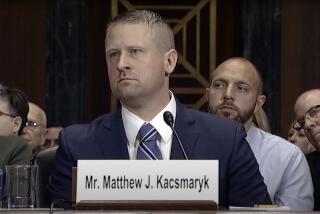Texaco Gets Set for New Life as Judge OKs Plan : Pennzoil Hurries to Invest Its $3 Billion--and to Party
- Share via
WHITE PLAINS, N.Y. — The curtain came down Wednesday on the largest bankruptcy case in the nation’s history when a federal bankruptcy judge approved Texaco’s $5.6-billion reorganization plan, 2 1/2 years after its courtroom defeat at the hands of Pennzoil.
The action by Judge Howard Schwartzberg was almost anticlimactic, because the final obstacles to Texaco’s emergence from its yearlong bankruptcy were removed a day earlier. But the relief among participants in the long drama was palpable.
L. Hugh Liedtke, chairman of Pennzoil, said he was moving immediately to invest the scheduled $3-billion payment it won from Texaco. Asked whether Pennzoil was planning any parties, he replied, “Is the Pope Catholic?”
And Texaco Chief Executive James W. Kinnear, setting aside the bitterness that pervaded the legal fight for months on end, said the company now “is prepared to emerge from Chapter 11 as a dramatically different company.”
The court’s decision means that Texaco is to leave its bankrupt status on April 7. Liedtke said he expects Texaco to wire its $3-billion payment on that date to the Texas Bank of Commerce. And analysts said Texaco will move quickly after that to begin selling off assets.
Under a previously outlined plan to restructure itself, Texaco intends to raise $3 billion through the sale of oil and gas properties and half-interests in its U.S. and European refineries.
Stage Set in December
Although shareholder and corporate raider Carl C. Icahn maintained his objections to some portions of the reorganization plan, Schwartzberg noted that Texaco’s shareholders, equity committee, creditors and management and Pennzoil itself support it. In his ruling, he said it “is fair and equitable and . . . is consistent with payments under the bankruptcy code.”
The stage for ending Texaco’s bankruptcy was set in December, when Pennzoil and Texaco reached an out-of-court settlement of their monumental battle stemming from Texaco’s takeover of Getty Oil in 1984.
A Texas jury, finding that Texaco had improperly interfered with a Pennzoil agreement to take control of Getty, awarded a record $10.3-billion judgment against Texaco in November, 1985. The company entered bankruptcy last April before agreeing out of court to pay Pennzoil $3 billion.
However, Texaco’s problems aren’t over. Icahn, who holds 14.8% of Texaco’s outstanding common shares, is still expected to seek seats on its board of directors. The company also faces a potential $6.5-billion bill for back taxes from the Internal Revenue Service.
On Wednesday, Icahn said in a statement that he was “pleased that the Texaco plan of reorganization has been confirmed and am happy to have played some role in obtaining the $3-billion settlement.” He did not state his intentions.
In his judgment Wednesday, Schwartzberg noted that Texaco’s only option other than the $3-billion payment to Pennzoil would be to petition the U.S. Supreme Court, because three appellate courts have upheld the original Texas court decision. He said a successful petition was unlikely.
“Accordingly, the shareholders would be substantially and adversely affected (if the Supreme Court turned the petition down),” he said.
Icahn’s major objection was to a provision in the reorganization plan that releases Texaco and Getty management and other executives from any further legal action stemming from their involvement in the Getty merger.
However, Schwartzberg cited testimony by Baine P. Kerr, chairman of Pennzoil’s executive committee, who had said that the releases were first introduced by Pennzoil, not Texaco. The judge then cited Lietdke’s testimony that the releases and indemnification were needed to get approval of the settlement plan.
“The releases and indemnities are in the best interest of Texaco in obtaining an integrated settlement,” Schwartzberg stated.
Pennzoil Borrows $3 Billion
The judge also rejected Icahn’s complaints about terms of a $3-billion bank financing plan arranged by Texaco to cover its payment to Pennzoil. The loan agreement stipulates that the banks can call the loan due if there is a change in control of Texaco management.
“I do not find that change of control is a management entrenchment feature,” the judge ruled. “The banks are certainly entitled to determine with whom they will deal. There is nothing in the language of the provision that says the banks have automatically precluded new owners from taking control or that new owners will be treated adversely.”
Liedtke, who attended the two-day hearing in bankruptcy court here, disclosed that Pennzoil has already arranged to borrow $3 billion itself, effective today, so that it can begin investing the money immediately.
“That money will be invested over the next 10 to 12 days, and when the Texaco check comes in, we will just pay off the banks,” Lietdke explained. He said his financial advisers determined that it was not possible to invest that large a sum of money quickly, so they decided to get a head start by borrowing the money and keeping it liquid in investments such as Treasury bonds.
“The purpose of the borrowing is to not pay exorbitant amounts to invest the money,” Liedtke said.
When asked whether Liedtke felt “financially whole” with the disposition of $3 billion, roughly $8 billion less than the original judgment had allocated, he responded, “Frankly, no. But it is best to get on with business.”
While Texaco has maintained to the end that it didn’t act improperly in the Getty negotiations, Liedtke commented Wednesday, “People do not pay $3 billion if they don’t have some liability.”
More to Read
Inside the business of entertainment
The Wide Shot brings you news, analysis and insights on everything from streaming wars to production — and what it all means for the future.
You may occasionally receive promotional content from the Los Angeles Times.










